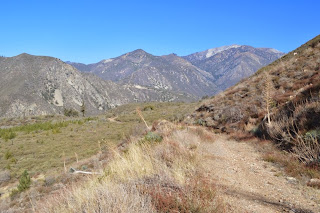Hiked Sunday, November 17. The week before my rain-soaked Red Rock Canyon hikes (Ice Box Canyon and Calico Hills/Lost Canyon), I hiked in Chino Hills State Park. Chino Hills is no Red Rock Canyon.
This was my fourth visit to Chino Hills State Park, and the third trailhead. My first visit was from Rim Crest Trail, which I hiked to San Juan Hill and Gillman Peak. The second trailhead was from Carbon Canyon, where the new Discovery Center visitor center is near the start of the trail.
This day's hike was from 4721 Sapphire Road. From this address, Bane Road heads south, into the park. This used to be the only way for the public to drive into the park. However, the road is being reconstructed (I don't know if it is going to be paved, but I would think so), and is closed to motor vehicles. However, with the construction season over, the road is now open for hiking, biking, and equestrian users.
Getting to the trailhead, I took CA-71 (the Chino Valley Freeway), a mostly-limited access route from I-10 (the San Bernardino Freeway) past the Pomona Freeway (CA-60), and on to the Riverside Freeway (CA-91). From CA-71, take Soquel Canyon Parkway, west. As you pass Butterfield Ranch Road, you'll see a shopping area to your right. This is the last facilities you'll see, as there's no restrooms or other facilities at the trailhead.
After Butterfield Ranch Road, continue west on Soquel Canyon Road for about 3/5 of a mile. A sign will direct you to a left turn, at Elinvar Road. After about 1/4 mile, Elinvar ends, a you must a make a 90-degree left turn, where the street changes name to Sapphire Road.
Bane Canyon Road enters immediately, on your right. Park anywhere in this area, though check to make sure you are parking on a street sweeping day. If so, park on the other side of the road.
On the day I hiked, there was a small pocket for maps near the entrance gate. It's an old map, however (dated 2002), so it has no update on what's going on with this road.
Hike on up the road. Expect mountain bikers on this, and nearly any of the trails.
North is to your back. South is straight ahead. Hills rise on either side. If it's clear, you can look back and see the San Gabriel Mountains. In the winter, they may be blanketed in snow.
The actual Chino Hills, however, are far too low for snow. Visit in the spring, and it's green rolling hills, or rolling hills covered in growing weeds (meaning, non-native plants). In the late summer or fall, it's mostly brown. Today, a few live oak were still green. Willow were mostly green, with a touch of yellow moving in. The sycamore were drier, with fewer leaves. Tree tobacco was also still growing green.
There was also the occasional bit of growth closer to the ground. A few bushes of sunflower, a few areas covered by datura, and a very few other sort of flowering plants. But it was mostly just dead grass. Not very scenic, other than that there were rolling hills of almost nothing, which is kind of rare in southern California.
Because of the lack of color, photo-graphing here is almost like a throwback exercise in shadows and light. Patterns attract your attention, but the patterns are mostly just variations of brown, or, as I said, of shadow and light. There was also the blue sky and the puffy white clouds. But that's about it.
On my hike this day, once I cleared the first rise, I took a trail heading to my right. It was the Bane Ridge Trail. I figured the view would be nice from up there.
Probably earlier than I intended, I descended past a powerline tower and joined the Bane Canyon Trail. I followed it for what seemed like at least 1/2 mile, eventually reaching some benches. From there, I stopped and studied my map some. Then I backtracked a bit to catch the "Longwayaround" trail, which would take me to McLean Overlook.
As I approached the viewpoint, I noticed an impressive outcropping. After first continuing to the viewpoint and looking in all directions at the rolling hills, I returned back to the side trail that would take me over the outcropping. This was the East Fence Line Trail.
This trail winds its way SLOWLY, and with many ups and downs and much following of ravine contour lines, followed by climbs into the next watershed. Eventually, the East Fenceline trail rejoins the Bane Canyon Trail, just 1/2 mile from Sapphire Road, and pretty much directly across the trail from where the Bane Ridge Trail had separated from Bane Canyon Trail in the other direction.
Hard to estimate total mileage, because that East Fenceline Trail really made a lot of turns. Anywhere from 6 to 8 miles of walking would be possible. I'll call it 7 miles for the day.
Good exercise, new territory covered, but not exactly outstanding scenery, and not significantly different from the landscape you see from the other trailheads.
The only other place I haven't been to in this park is the area down to the southwest, in Aliso Canyon. I'll have to try to find a good trailhead for that portion.
Kenda Klever RT - One Year Review
-
TL;DR - The Kenda's have performed VERY well in all conditions (better than
the S/T Maxx) and have been a great tire. I'm trying to find a way to get
light...
3 days ago










































